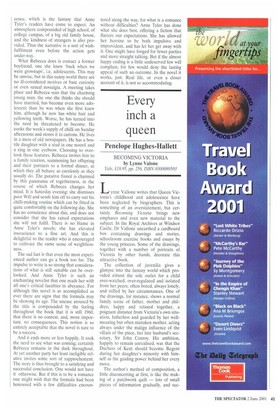Every inch a queen
Penelope Hughes-Hallett
BECOMING VICTORIA by Lynne Valone Yale, £18.95, pp. 256, ISBN 0300089503 Lynne Vallone writes that Queen Victoria's childhood and adolescence have been neglected by biographers. This is something of an overstatement, but certainly Becoming Victoria brings new emphases and even new material to the subject. In the Royal Archives at Windsor Castle, Dr Vallone unearthed a cardboard box containing drawings and stories, schoolroom exercise books and essays by the young princess. Some of the drawings, together with a number of portraits of Victoria by other hands, decorate this attractive book.
The collection of juvenilia gives a glimpse into the fantasy world which provided almost the sole outlet for a child over-watched, over-regulated and isolated from her peers, often bored, always lonely, and stifled by her circumstances. One of the drawings, for instance, shows a normal family scene of father, mother and children, happy and relaxed together, a poignant distance from Victoria's own situation, fatherless and guarded by her wellmeaning but often mistaken mother, acting always under the malign influence of the villain of the piece, her late husband's secretary, Sir John Conroy. His ambition, happily to remain unrealised, was that the Duchess of Kent should become Regent during her daughter's minority with himself as the guiding power behind her every move.
The author's method of composition, a little disconcerting at first, is like the making of a patchwork quilt — lots of small pieces of information gradually, and suc cessfully, resulting in a well-rounded picture of the emotional development of her extraordinary protagonist. Many of the old stories are here: Victoria's uncle, William IV, leaning from his carriage in the park and saying to her, 'Give me your little paw', then insisting on having her transferred from her mother's vehicle to sit by him. There is the princess, on being shown a sheet of paper making plain that she was the heir presumptive to the throne, making the correct deduction and exclaiming, 'I will be good'; and in the culminating scene of her girlhood, when the Archbishop of Canterbury and the Lord Chamberlain arrived at Kensington Palace at six o'clock in the morning to announce the death of the King, we see Victoria marking her new status by insisting on receiving them 'alone' — the word is heavily underlined in her journal, and sounds the death knell of Conroy's power, But Lynne Vallone succeeds in bringing fresh life to these episodes.
She is good, too, on the princess's character traits: her stubbornness, and her endearing capacity for love. She adored her uncle, King Leopold of the Belgians, and her half-sister Feodora, though she had to depend for the most part on their letters and on their infrequent visits to England, her daily prop and stay being her beloved governess, her 'dearest, best' Baroness Lehzen. However shockingly mistaken her upbringing may now appear, it must have been a factor in enabling the tiny 18-yearold figure — standing at just four feet eleven inches — to step so confidently out on to the world stage that famous early morning.











































































 Previous page
Previous page